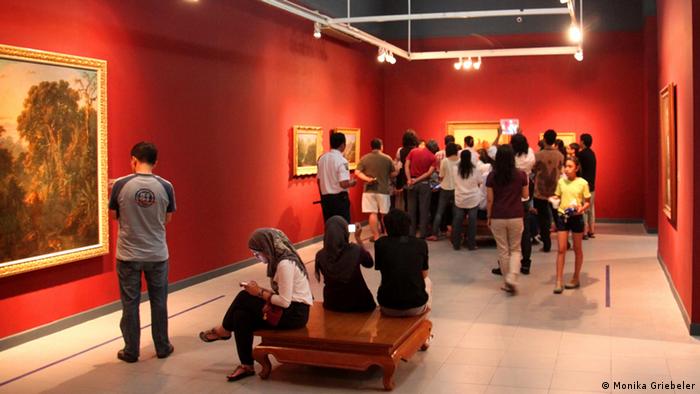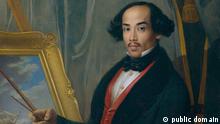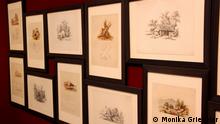Raden Saleh - Wikipedia, the free encyclopedia
Raden Saleh Sjarif Boestaman (1807 or 1811 - April 23, 1880) is one of the best known painters from Indonesia and a pioneer of modern Indonesian art. He was ...
Germany celebrated Raden Saleh as a 'painting prince from the
Orient.' For a long time, post-colonial Indonesia wanted nothing to do
with him, but the pioneer's work has just been showcased for the first
time.
"Saleh was one of the great modernizers of Indonesian society," says
the curator of a pioneering exhibition in Jakarta called "Raden Saleh
and the Beginning of Modern Indonesian Painting" Werner Kraus. "At the
same time, he brought orientalism to Germany."
Saleh was born into the Javanese nobility in 1811 and went to Europe to study art at the age of 18. He spent more than 20 years in Europe, living in Amsterdam, Paris and Dresden.
 A self-portrait of the artist
A self-portrait of the artist
He felt most comfortable in Germany, where he was welcomed with open
arms. "He was received at the royal court and invited to all the
salons," explains Kraus. "In the area around Dresden he was known as the
‘black prince'. He was very popular and his art sold at very high
prices."
"In Holland, however, he was seen as a brown person from the colonies and was not taken so seriously," he adds.
Subverting themes
"Saleh was a cosmopolitan who sought out styles that he liked," explains John Clarke, an art history professor at Sydney University. He painted portraits, landscapes, hunting scenes, battles, combining romanticism with orientalism and often subverting the themes.
"If for example, animals fight with one another, say a lion attacks a noble horse, then it's about the relationship with the colonial master Holland," he says. "Civilization versus barbarism - and there is nothing to say that the Dutch are the civilized ones."
Penangkapan Diponegoro - Saleh's most famous oil painting - depicts the arrest of Prince Diponegoro at the end of the Java War (1835-1830).
The heads of the Dutch, against whom Diponegoro led an eventually unsuccessful rebellion, are disproportionately big. It was Saleh's way of portraying the arrogance of the colonial masters.
A sense of betrayal
Although Saleh is considered the founder of modern Indonesian painting, his works have never been exhibited in the country of his birth. If he is known at all, it is because his name adorns certain streets or squares in the country.
"Even the wider, educated middle-class doesn't know him anymore," says Franz Xaver Augustin, the head of the Goethe Institute in Jakarta. He co-organized the exhibition showcasing the painter's works at the National Gallery.
 Werner Kraus published a biography of Raden Saleh in 2004A
Werner Kraus published a biography of Raden Saleh in 2004A
"Everything to do with Holland was rejected during the decolonization
period. Even if Raden Saleh was critical, there was a sense he had
betrayed Indonesia," he explains.
Very popular
The show, which has just closed, featured some 40 paintings from public and private collections in Indonesia and attracted over 10,000 visitors, making it one of the most popular art exhibitions in the country ever.
Kraus attributes the popularity to the rise of nationalism in recent years and says that Saleh's value has increased dramatically. "The prices being paid for these 19th-century paintings are unimaginable to us."
Indonesian art historian Farah Wardani adds that it has become a status symbol for private collectors to own a painting by Saleh.
One example of his popularity is that "Last Resort," a painting of a hunting scene that he painted in Dresden in 1842, was sold off at an auction to an Indonesian buyer last year for 1.6 million euros. For decades, it had hung unobtrusively in a Ruhr Valley boardroom.
Poles apart
Saleh returned to Indonesia in 1852 because he was homesick. "He had a great project when he came back," Kraus explains. "He wanted to be respected in colonial Indonesia just as he had been in Europe."
 Pictures by schoolchildren inspired by Raden Saleh
Pictures by schoolchildren inspired by Raden Saleh
He described his experience thus: "Two poles diametrically opposed to
each other, both bright and friendly, exert a powerful spell on my
soul."
However, he and his trans-cultural lifestyle were rejected by the colonial masters. In 1869, he was even arrested and accused of leading a farmers' rebellion. Although he was quickly vindicated, he was unable to cope with the shame and the lack of acceptance.
He was Javanese when he came to Europe and German when he returned to Indonesia. In the end the "two poles" were his doom; yet they helped contribute to Indonesia's cultural richness.
Author: Monika Griebeler / act
Editor: Richard Connor
Saleh was born into the Javanese nobility in 1811 and went to Europe to study art at the age of 18. He spent more than 20 years in Europe, living in Amsterdam, Paris and Dresden.
 A self-portrait of the artist
A self-portrait of the artist"In Holland, however, he was seen as a brown person from the colonies and was not taken so seriously," he adds.
Subverting themes
"Saleh was a cosmopolitan who sought out styles that he liked," explains John Clarke, an art history professor at Sydney University. He painted portraits, landscapes, hunting scenes, battles, combining romanticism with orientalism and often subverting the themes.
"If for example, animals fight with one another, say a lion attacks a noble horse, then it's about the relationship with the colonial master Holland," he says. "Civilization versus barbarism - and there is nothing to say that the Dutch are the civilized ones."
Penangkapan Diponegoro - Saleh's most famous oil painting - depicts the arrest of Prince Diponegoro at the end of the Java War (1835-1830).
The heads of the Dutch, against whom Diponegoro led an eventually unsuccessful rebellion, are disproportionately big. It was Saleh's way of portraying the arrogance of the colonial masters.
A sense of betrayal
Although Saleh is considered the founder of modern Indonesian painting, his works have never been exhibited in the country of his birth. If he is known at all, it is because his name adorns certain streets or squares in the country.
"Even the wider, educated middle-class doesn't know him anymore," says Franz Xaver Augustin, the head of the Goethe Institute in Jakarta. He co-organized the exhibition showcasing the painter's works at the National Gallery.
 Werner Kraus published a biography of Raden Saleh in 2004A
Werner Kraus published a biography of Raden Saleh in 2004AVery popular
The show, which has just closed, featured some 40 paintings from public and private collections in Indonesia and attracted over 10,000 visitors, making it one of the most popular art exhibitions in the country ever.
Kraus attributes the popularity to the rise of nationalism in recent years and says that Saleh's value has increased dramatically. "The prices being paid for these 19th-century paintings are unimaginable to us."
Indonesian art historian Farah Wardani adds that it has become a status symbol for private collectors to own a painting by Saleh.
One example of his popularity is that "Last Resort," a painting of a hunting scene that he painted in Dresden in 1842, was sold off at an auction to an Indonesian buyer last year for 1.6 million euros. For decades, it had hung unobtrusively in a Ruhr Valley boardroom.
Poles apart
Saleh returned to Indonesia in 1852 because he was homesick. "He had a great project when he came back," Kraus explains. "He wanted to be respected in colonial Indonesia just as he had been in Europe."
 Pictures by schoolchildren inspired by Raden Saleh
Pictures by schoolchildren inspired by Raden SalehHowever, he and his trans-cultural lifestyle were rejected by the colonial masters. In 1869, he was even arrested and accused of leading a farmers' rebellion. Although he was quickly vindicated, he was unable to cope with the shame and the lack of acceptance.
He was Javanese when he came to Europe and German when he returned to Indonesia. In the end the "two poles" were his doom; yet they helped contribute to Indonesia's cultural richness.
Author: Monika Griebeler / act
Editor: Richard Connor
沒有留言:
張貼留言